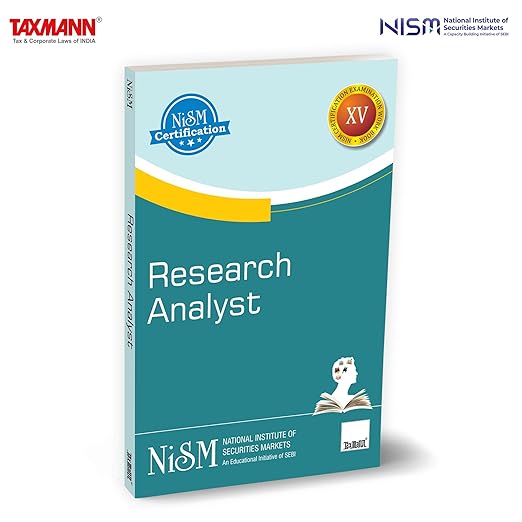This comprehensive workbook aims to establish a common minimum knowledge benchmark for professionals registered as Research Analysts under SEBI (Research Analyst) Regulations, 2014, as well as individuals employed as research analysts and partners of research analyst firms. It provides a thorough grounding in the fundamental and practical aspects of analysing Equity and debt instruments, evaluating industry dynamics, understanding macroeconomic and microeconomic variables, and writing high-quality research reports.
It is helpful for finance students, market enthusiasts, and anyone keen on enhancing their knowledge of equity and debt markets, honing analytical skills, and understanding the regulatory framework of the securities industry.
The Present Publication is the September 2024 Workbook Version, developed in collaboration with the Certification Team of NISM and Mr Manish Bansal and reviewed by Mr Bihari Lal Deora, NISM's Resource Person. It is published exclusively by Taxmann, with the following noteworthy features [Understand Indian Securities Markets] Acquire foundational knowledge of market structures, terminologies, and participants in both equity and debt segments [Apply Top-Down & Bottom-Up Approaches] Grasp how to integrate macroeconomic indicators with detailed company-specific insights for holistic fundamental research [Conduct Micro & Macro-Economic Analysis] Master the interpretation of key economic variables—such as GDP growth, inflation, and interest rates—that shape broader investment scenarios [Evaluate Industries & Companies]
o Discover method... See more
This comprehensive workbook aims to establish a common minimum knowledge benchmark for professionals registered as Research Analysts under SEBI (Research Analyst) Regulations, 2014, as well as individuals employed as research analysts and partners of research analyst firms. It provides a thorough grounding in the fundamental and practical aspects of analysing Equity and debt instruments, evaluating industry dynamics, understanding macroeconomic and microeconomic variables, and writing high-quality research reports.
It is helpful for finance students, market enthusiasts, and anyone keen on enhancing their knowledge of equity and debt markets, honing analytical skills, and understanding the regulatory framework of the securities industry.
The Present Publication is the September 2024 Workbook Version, developed in collaboration with the Certification Team of NISM and Mr Manish Bansal and reviewed by Mr Bihari Lal Deora, NISM's Resource Person. It is published exclusively by Taxmann, with the following noteworthy features [Understand Indian Securities Markets] Acquire foundational knowledge of market structures, terminologies, and participants in both equity and debt segments [Apply Top-Down & Bottom-Up Approaches] Grasp how to integrate macroeconomic indicators with detailed company-specific insights for holistic fundamental research [Conduct Micro & Macro-Economic Analysis] Master the interpretation of key economic variables—such as GDP growth, inflation, and interest rates—that shape broader investment scenarios [Evaluate Industries & Companies]
o Discover methods for analysing industry trends, cycles, and regulatory landscapes
o Learn to assess a company's qualitative and quantitative aspects, including business models, competitive advantages, and financial statements [Analyse Risk & Return]
o Understand the basics of calculating various forms of returns (simple, annualised, and compounded)
o Explore risk measurement tools like Beta and sensitivity analysis and understand the behavioural biases affecting investment decisions [Master Valuation Principles & Corporate Actions]
o Study discounted cash flow (DCF) techniques, relative valuation, and other metrics essential for accurately valuing companies
o Examine how corporate actions—dividends, bonuses, rights issues, mergers—impact stock valuations and investment decisions [Draft Quality Research Reports]
o Learn the critical components of a high-calibre research report
o Implement a checklist-based approach to maintain accuracy and clarity [Navigate Regulatory Frameworks]
o Understand the roles of SEBI, stock exchanges, and relevant regulations designed to protect investor interests
o Stay informed about ethical and disclosure obligations for Research Analysts
The coverage of the book is as followsChapter 1 – Introduction to Research Analyst Profession
o Outlines the primary roles, responsibilities, and key qualities expected of a Research AnalystChapter 2 – Introduction to the Securities Market
o Explains the fundamentals of securities, market structure, and dematerialisation processesChapter 3 – Terminology in Equity & Debt Markets
o Decodes industry-specific jargon, types of bonds, and market instrumentsChapter 4 – Fundamentals of Research
o Walks through the purpose of investing, different methods of analysis (technical, fundamental, quantitative, and behavioural) Chapter 5 – Economic Analysis
o Details the micro and macroeconomic concepts crucial for top-down research and identifies sources of economic dataChapter 6 – Industry Analysis
o Offers frameworks for assessing industries, evaluating cyclicity, and understanding key drivers and regulatory landscapesChapter 7 – Company Analysis (Business & Governance)
o Discusses business models, competitive strengths, SWOT analysis, governance quality, and ESG factorsChapter 8 – Company Analysis (Financial Analysis)
o Provides a deep dive into reading financial statements, ratio analysis, forecasting, and peer comparisonChapter 9 – Corporate Actions
o Explores the rationale and impact of various corporate actions on investment decisionsChapter 10 – Valuation Principles
o Examines different valuation methodologies, from asset-based models to modern valuation metrics used in new-age businessesChapter 11 – Fundamentals of Risk & Return
o Focuses on measuring and managing risk, calculating returns, and understanding behavioural aspects of investmentChapter 12 – Qualities of a Good Research Report
o Highlights best practices and a structured approach to producing effective research reportsChapter 13 – Legal & Regulatory Environment
o Discusses critical regulations, code of conduct, and conflict-of-interest disclosures in research analysis






